MACRO EXTENSION TUBES & CLOSE-UP LENSES
Macro extension tubes and close-up lenses are devices that add high magnification capabilities to virtually any camera lens. This can give a whole new range of subject matter to your existing camera equipment. However, it's often unclear exactly how much magnification you'll gain, in addition to whether one of the other macro options will provide a better solution for your needs, such as purchasing a dedicated macro lens.
EXTENSION TUBES OVERVIEW
An extension tube is simply a hollow cylinder that fits in between your camera and lens, causing the lens to move farther from the sensor. This additional distance allows your lens to focus more closely, which in turn provides more magnification capability. Unlike most lens accessories, extension tubes don't add any extra optics, and are therefore relatively inexpensive, simple devices.
 |
||
| Choose a Magnification: | 1:2 (0.5X) | 1:1 (1.0X) |
Note: Diagram assumes that the lens is symmetric (pupil magnification = 1).
An extension tube increases lens magnification by an amount equal to the extension distance divided by the lens focal length. For example, adding a 25 mm extension tube to a 50 mm lens will give a magnification gain of 0.5X. Therefore, if the lens's original magnification was 0.15X, then the new magnification will be 0.15X+0.5X=0.65X. The closest focusing distance will also decrease to ~210 mm.
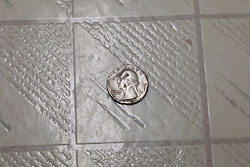 0.15X Max Magnification
0.15X Max Magnificationwith typical 50 mm lens
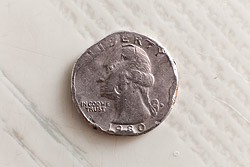 0.65X Max Magnification
0.65X Max Magnificationafter 25 mm extension tube
Note: above example is shown using a full frame camera and a Canon EF 50 mm f/1.4 lens.
All camera lenses have some amount of native extension, which is used to focus on everyday objects. Lenses with closer focusing distances usually have more native extension, but these will also benefit less from extension tubes. Try experimenting with different lenses in the calculator below to see how extension affects magnification:
Note: "closest focusing distance" is defined as the distance from the camera's sensor to the subject.
Note how extension tubes provide minimal magnification when used with telephoto lenses — which is unfortunately their main weakness.
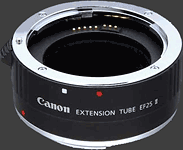
An extension tube is usually specified in terms of its extension length in millimeters. Most manufacturers provide a range of extensions from 8-35 mm, although multiple extension tubes can be stacked to increase the extension even farther. Examples include the Canon 25 mm EF II, the Nikon 8 mm PK-8 and the Kenko DG 12 mm, amongst many others. Extension tubes also usually include basic electronics to pass through signals between the lens and the camera body (such as for autofocus).
Important considerations. Image quality shouldn't be a factor when deciding between different brands of extension tubes (all use the same low dispersion air). However, build quality may be an important consideration — particularly if you plan on using it with a heavy telephoto lens. Additionally, older extension tubes don't always work with newer lenses designed for cropped SLR sensors.
PROS & CONS OF EXTENSION TUBES
While extension tubes are an amazingly flexible solution, they're not always the best option for your photography. One should weigh the pros and cons appropriately:
Extension Tube Advantages
- Much less expensive than purchasing a dedicated macro lens.
- Provides a flexible and upgradable increase in magnification with virtually any camera lens — even existing macro lenses.
- Doesn't place additional glass elements between your subject and your camera
(thereby minimizing any potential loss in image quality). - Provides consistent, predictable quality regardless of extension tube brand.
Extension Tube Disadvantages
- Provides only a minimal magnification gain with telephoto lenses.
- Causes your lens to lose the ability to focus on distant objects.
- F-stop set by your camera might not represent the effective f-stop from extension
(as described in the tutorial on macro lenses: effective f-stop). - Causes your lens to focus more closely than it was designed. High magnification images will therefore usually have lower quality than with a dedicated macro lens.
- Requires that you remove your lens from the camera each time you wish to change the amount of extension (which raises the risk of dust settling on your camera sensor).
- With zoom lenses, the image can go quickly out of focus as one zooms in or out.
If any of the above disadvantages has the potential to be a problem, it's worth considering using either a dedicated macro lens or a close-up filter (next section).
CLOSE-UP LENSES OVERVIEW
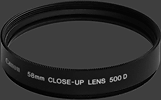
Close-up lenses are special lenses that screw onto the front of your lens like an ordinary camera lens filter. They're basically just a sophisticated magnifying glass that's placed between your lens and the subject. It's for this reason that they're also often called "close-up filters."
A close-up filter works by decreasing the effective focal length of whatever lens they're used on. This decrease in focal length means that the extension has to increase correspondingly — which ends up magnifying the image similar to if one were to have used an extension tube:
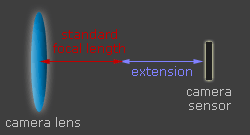
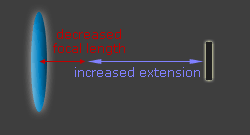
A close-up filter is usually specified in terms of "diopters," which is a measure of their magnifying power. Higher numbers yield more relative magnification on a given lens, but image quality also tends to decrease correspondingly. Typical values range from +2 to +5 diopters, although multiple close-up lenses can be combined to increase this further.
Note how close-up filters increase magnification much more when used with longer focal length lenses. For example, a 50 mm lens requires +10 diopters to achieve a magnification gain of just 0.5X, whereas a 200 mm lens requires only +2.5 diopters. Conversely, a given close-up lens might be too powerful (and decrease image quality too much) when used on a 200 mm telephoto lens, but might be just right on an 80 mm lens.
PROS & CONS OF CLOSE-UP LENSES
As with extension tubes, it's important to weigh the unique pros and cons of adding a close-up lens to gain magnification:
Close-up Lens Advantages
- Provides more magnification than extension tubes when used with telephoto lenses:
| Lens Focal Length |
Native Magnification |
with Extension Tubes |
with Close-up Lenses |
|||
|---|---|---|---|---|---|---|
| 12 mm | 25 mm | +2 Diopters | +4 Diopters | |||
| 50 mm | 0.15X | → | 0.39X | 0.65X | 0.25X | 0.45X |
| 100 mm | 0.14X | → | 0.26X | 0.39X | 0.34X | 0.54X |
| 200 mm | 0.16X | → | 0.22X | 0.29X | 0.56X | 0.96X |
Lenses used for above comparison:
Canon EF 50 mm f/1.4 USM, Canon EF 100 mm f/2.0 USM, Canon EF 200 mm f/2.8 II USM
- Retains more light at a given f-stop setting when compared to extension tubes
(since the effective aperture no longer increases). However, when both are set to the same depth of field and magnification, both capture roughly the same amount of light. - Doesn't require removing the lens from the camera body.
Close-up Lens Disadvantages
- Inconvenience. A different close-up lens is required for each filter size; close-up lenses are also unavailable in filter sizes greater than 77 mm.
- Provides a minimal magnification gain when used with focal lengths less than ~80 mm.
- Causes your lens to lose the ability to focus on distant objects.
- Decreases the working distance for a given amount of magnification
(the distance between the subject and the front of your lens) - Places additional glass between your camera and subject, which may decrease image quality. However, double element close-up lenses minimize most of this quality loss.
- Often more expensive than extension tubes (but less than a dedicated macro lens).
- May prevent your lens from being able to use other filters.
OTHER MACRO OPTIONS
While extension tubes and close-up lenses are the two most common ways to increase magnification, other options exist. Popular alternatives include the following:
Teleconverters. Even though these are typically used to increase a lens's focal length, they're also a popular way to increase magnification. The teleconverter multiplier directly correlates with the increase in magnification; a 2X teleconverter therefore doubles the maximum magnification. Disadvantages include (i) a loss in image quality and (ii) an increase in the len's minimum f-stop (max aperture), which may prevent a camera from being able to autofocus.
Bellows. These are basically adjustable length extension tubes. They're typically much more expensive than normal extension tubes, but also often enable your lens to make tilt/shift movements to reposition the depth of field. However, bellows can be quite cumbersome, so studio/tripod use is usually a requirement.
Reversing Rings. These allow your lens to be mounted in the reverse direction. They attach to your camera where you would normally mount the lens; your lens's front filter mount then screws onto the reversing ring, causing the inner (and normally hidden) part of your lens to face outward. Shorter focal length lenses will allow for closer focusing distances and higher magnification. The main disadvantage of reverse rings is that they result in an extremely narrow range of distances which can be in focus. Other complications potentially include the loss of aperture control and autofocus.
Cropping. You can enhance the size of a subject in a print by simply cropping the image. This is an easy and powerful option if you have some extra resolution to spare (which is increasingly the case with today's high megapixel cameras).
If any given lens add-on provides insufficient magnification, it's also common to see macro photographers combining/stacking multiple add-ons. One could use a teleconverter along with an extension tube, for example, or a bellows in addition to a close-up lens.
For a more general overview of macro lenses, also see the tutorial on:
Macro Lenses: Magnification, Depth of Field & Effective F-Stop
For an introductory article, also see the Introduction to Macro Photography Technique

